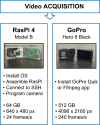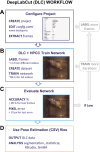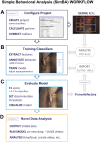Analysis of Operant Self-administration Behaviors with Supervised Machine Learning: Protocol for Video Acquisition and Pose Estimation Analysis Using DeepLabCut and Simple Behavioral Analysis
- PMID: 39774006
- PMCID: PMC11826966
- DOI: 10.1523/ENEURO.0031-24.2024
Analysis of Operant Self-administration Behaviors with Supervised Machine Learning: Protocol for Video Acquisition and Pose Estimation Analysis Using DeepLabCut and Simple Behavioral Analysis
Abstract
The use of supervised machine learning to approximate poses in video recordings allows for rapid and efficient analysis of complex behavioral profiles. Currently, there are limited protocols for automated analysis of operant self-administration behavior. We provide a methodology to (1) obtain videos of training sessions via Raspberry Pi microcomputers or GoPro cameras, (2) obtain pose estimation data using the supervised machine learning software packages DeepLabCut (DLC) and Simple Behavioral Analysis (SimBA) with a local high-performance computer cluster, (3) compare standard Med-PC lever response versus quadrant time data generated from pose estimation regions of interest, and (4) generate predictive behavioral classifiers. Overall, we demonstrate proof of concept to use pose estimation outputs from DLC to both generate quadrant time results and obtain behavioral classifiers from SimBA during operant training phases.
Keywords: DeepLabCut; Raspberry Pi; Simple Behavioral Analysis (SimBA); operant behavior; pose estimation; predictive classifiers; self-administration; video recording.
Copyright © 2025 Pereira Sanabria et al.
Conflict of interest statement
The authors declare no competing financial interests.
Figures








Similar articles
-
High quality, high throughput, and low-cost simultaneous video recording of 60 animals in operant chambers using PiRATeMC.J Neurosci Methods. 2024 Nov;411:110270. doi: 10.1016/j.jneumeth.2024.110270. Epub 2024 Aug 31. J Neurosci Methods. 2024. PMID: 39222797
-
Tracking Rats in Operant Conditioning Chambers Using a Versatile Homemade Video Camera and DeepLabCut.J Vis Exp. 2020 Jun 15;(160). doi: 10.3791/61409. J Vis Exp. 2020. PMID: 32597866
-
Comprehensive ethological analysis of fear expression in rats using DeepLabCut and SimBA machine learning model.Front Behav Neurosci. 2024 Aug 1;18:1440601. doi: 10.3389/fnbeh.2024.1440601. eCollection 2024. Front Behav Neurosci. 2024. PMID: 39148895 Free PMC article.
-
A methodology for the annotation of surgical videos for supervised machine learning applications.Int J Comput Assist Radiol Surg. 2023 Sep;18(9):1673-1678. doi: 10.1007/s11548-023-02923-0. Epub 2023 May 28. Int J Comput Assist Radiol Surg. 2023. PMID: 37245179 Review.
-
Using deep learning to study emotional behavior in rodent models.Front Behav Neurosci. 2022 Nov 22;16:1044492. doi: 10.3389/fnbeh.2022.1044492. eCollection 2022. Front Behav Neurosci. 2022. PMID: 36483523 Free PMC article. Review.
References
MeSH terms
LinkOut - more resources
Full Text Sources
Research Materials
Miscellaneous
